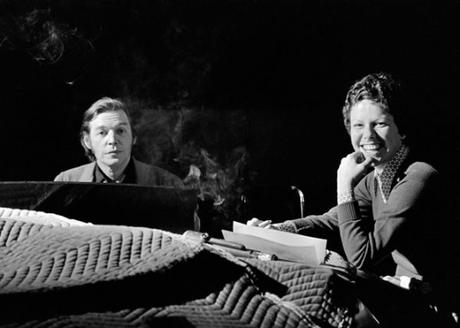 Elis Regina (Photo: last.fm)
Elis Regina (Photo: last.fm)
- The Author
The month was mid-July, the year 1971. I had just turned seventeen, but was still thirteen months away from my high school graduation. Unsure of what to do, unclear as to what path I might lead, I struggled with the thought of what the next four years would be like.
Over on the distaff side, Elis Regina Carvalho Costa, at age twenty-six, was already Brazil's most popular recording and concert artist. She was born on March 17, 1945, in the southern city of Porto Alegre, State of Rio Grande do Sul. Yet, wherever I traveled around the vicinity of São Paulo, and whoever I met or discoursed with - especially in the households of cousins, friends, and family members my age or older - the topic would unavoidably come around to the singer's powerful vocals.
That's where I stumbled: "Elis ... Elis ... What's her name again?" I would inquire.
"Elis Regina," came the response. "Why do you ask? Don't you like her?"
I must confess that, at the time, I felt embarrassed, confused, and completely out of my element at being placed in the delicate position of having to defend my ignorance.
My excuse for being in such a tortured, tongue-tied state was that I had no idea who Elis Regina (her stage name) was or what she had sung that made her so well known. Although I kept hearing one of her songs on countless occasions, once our Brazil trip was over and we returned to New York City, for the life of me I could not recall the title of that piece, nor could I tuck away the melody into any conceivable corner of my memory for future reference. I knew the number to be extremely catchy, though, and oh-so-heavily pop driven. But beyond that, I was left adrift.
Psychologically, I must have blocked the song from my subconscious. Indeed, there could be no other explanation for my apparent brain freeze. Not that I disliked the number - to be honest, I reveled in its light and airy feel, coupled with the loose approach that Elis took in the Philips album that introduced it. It reminded me of something Sinatra might have taken a "nice and easy" approach to in his day.
But no matter how hard I struggled, no matter how many Google searches I launched throughout the coming years (and then some!), in a last-ditch effort at naming this enigmatic tune, I was unable to pin the title down.
And then, out of nowhere, the mystery was resolved.
One weekend in mid-August 2020, I happened to have been on the cellphone with my brother Anibal, explaining to him that I had just about finished the Fat Lady's story; that the last thing I needed to get straight was this missing chapter about the pop star, Elis Regina. Our discussion then turned to that unnamed song and my lingering frustration with it.
"Oh, yeah, I know it," he stated calmly.
"What? You know it? After all this time?"
"Sure," he confirmed. Instantly, my brother began to hum the mysterious tune, the one that had been wracking my middle-aged intellect for so long.
"My God, you remembered! That's it!" I shouted. "That's the song!"
Exhilarated at the prospect of having finally unraveled this decades-long conundrum, I rushed to the living room and handed the cellphone to my wife, Maria Regina, our resident expert on Brazilian pop and - another stroke of luck - the one person who considered her namesake to be among her favorites.
"Dear, quick! What's the name of this tune? My brother's going to hum it for you."
Thank goodness my wife remembered the song, but, like me, the title had completely escaped her. My hopes seemed to have been dashed in the moment of claiming victory. Still, both she and my brother continued to hum the number together. Well, if they didn't know the title, at least they were familiar with the melody (she even mouthed some of the words). There was hope after all!
After a quick look-up on YouTube, it finally came to her: the title, that seemingly unattainable object of my desire; the one that had so eluded detection for nearly half a century.
"Here it is," she announced triumphantly. " 'Vou deitar e rolar.' "
Ah, so that's it! "Vou deitar e rolar" (loosely translated as "I'll make my bed and lie in it"), written in 1970 for the album ... Em Pleno Verão ("... At the Peak of Summer"). The authors were songwriter-guitarist Baden Powell and poet-composer Paulo Cesar Pinheiro, both natives of Rio de Janeiro and known quantities in the pop-music world. Produced by the ubiquitous Nelson Motta, with arrangements by Erlon Chaves, Elis Regina's bandmates included José Roberto Beltrami on piano, Luiz Claudio Ramos on guitar, Luizão Maia on bass, Wilson das Neves on drums, and Hermes Contesini on percussion.
As bouncy as a Copacabana beach ball, as refreshing as the carioca dew at sunrise, this irresistible number was delivered by a performer at the absolute peak of her profession. The song makes reference to a girl who, aware of having been two-timed by her lover, shoves the betrayal to his face by vowing to "do her own thing" no matter what. He's shown the door with a hearty "Ha-ha-ha-ha-ha," a sendoff that indicates to her former paramour that "She who laughs last, laughs best."
The song illustrated both the highs and the lows of a remarkable singing career that began at age fifteen and ended prematurely at thirty-six.

Audacious, extroverted, and charismatic on the stage and on live television, the highly-charged personality known as Elis Regina was capable of turning shy in private, even reserved to the point of inhibition. Decidedly pugnacious when the mood suited her, she was also fearless and confrontational. At times, Elis experienced a devastating stage fright before a performance - astonishing for one with such a natural-born propensity for picking the right style for every occasion.
For example, in 1965 she debuted on national television, in the First Festival of Popular Music, with "Arrastão" ("Fish Net"), a song about a poor Northeastern fisherman written by singer-composer Edu Lobo and the poet Vinicius de Moraes. Sporting a beehive hairdo (which made her look like one of The B-52's) and extending her arms high above her head, Elis swung her limbs in a backwards swimming motion. To most viewers, she appeared to mimic the rotating blades of an airplane, movements that baptized her with the first of several nicknames: "Hélice" Regina, or "Propellor" Regina. It also won her nationwide recognition.
At other times, Elis would turn destructive - what today might be diagnosed as bipolar disorder, earning her the sobriquet pimentinha ("little pepper," which also described Dennis the Menace). She took no prisoners by wrecking not only her associations with men and women, but damaging their personal property as well: The well-worn story of her flinging ex-husband Ronaldo Bôscoli's entire Sinatra collection into the sea is, unfortunately, true (the discs were last "spotted" somewhere off the coast of West Africa).
I can hear it now: "Let it all go to hell!"
That sounds like something Furacão ("Hurricane") Elis would have said. With few exceptions, her choice of repertoire was frequently eclectic as well. Despite kicking off her recording career with the 1961 album, Viva a Brotolândia ("Long Live Teenybopperdom"), devoted to adolescent drivel, Elis displayed a seasoned professional's knack for capturing exactly the sound the pubic was yearning for.

And contrary to what most pop-music mavens might have believed, she did not possess a natural "voice" for bossa nova but rather developed her skills through trial and error. Elis eventually came to grasp what the bossa nova idiom had begun to imply: that is, as a window into other Brazilian song forms and influences. In her mind, samba and pop blazed a much wider (and richer) trail, and were a lot more diverse and meaningful, than bossa nova's basic "love, flower, ocean" theme would have you believe. In that, she shared the sentiments (on and off the spotlight) of her nearest rival, Nara Leão.
Yet, of all the aspiring female talents at or below her level of excellence (and there was quite a hefty assortment to choose from), Elis Regina is the only one, in my mind, to have been considered worthy of comparison to her illustrious predecessor, the equally volatile Carmen Miranda.
It came as no surprise that both Carmen and Elis were of Portuguese descent, as were a sizeable proportion of Brazilians. Both artists were short of stature (five-feet-two-inches tall), both came from poor working-class backgrounds, and both had extraordinarily productive careers inside and outside Brazil, despite negative reaction from the public and press. With respect to their financial compensation, they were the highest paid female entertainers of their generation. Accordingly, both died from substance abuse: in Carmen's case, from alcohol mixed with barbiturates and amphetamines; in Elis Regina's, from cocaine and Campari.
What surprised me the most, in researching this topic, was that few if any authors have pointed the above coincidences out to readers. One can only conclude that Carmen and Elis had artificially extended their lives beyond all reasonable limitations because of their early demise. As iconic symbols of their respective fields, they had outlived the normal passage of time.
At first, Elis, to her good fortune, managed to survive the so-called "curse of twenty-seven," the age at which many of her contemporaries (Brian Jones, Janis Joplin, Jimi Hendrix, Jim Morrison) succumbed to personal demons with their premature passing. That Elis' cocaine use came near the end of her short life is doubly unfortunate.
Still, in spite of their professional accomplishments, Carmen and Elis' private lives were anything but tranquil. Carmen's sole marriage to a non-Brazilian was loveless and abusive, while Elis' two marital relationships ended in separation and divorce. The difference between them was that Elis left three young children for posterity (a boy, João Marcelo, from Bôscoli; and a boy and a girl, Pedro and Maria Rita, from second husband, pianist Cesar Camargo Mariano), whereas Carmen left no progeny behind.
That 'Sinatra' Moment
If the Brazilian Bombshell's latter-day notoriety as an emblem of gay culture has brought renewed interest in her artistry, then Elis Regina's elevated status as Brazil's most complete singer-performer can be reasonably assured.
And as far as her fans and audiences were concerned, her time had finally come. Between February 22 and March 9, 1974, at MGM Studios in Los Angeles, the recording of the album Elis & Tom took place. An acknowledged "greatest hits" package of Antonio Carlos Jobim's most accessible song works, involving three of his favorite songwriting partners (Vinicius, Chico Buarque, Aloysio de Oliveira), a number of items on Elis & Tom were arranged by the singer's soon-to-be-husband Cesar Camargo Mariano.
Listening to the album after so many years, the first thing one notices is that Elis had modulated her famously potent delivery to this more-intimate lounge setting. Compare her rendition of "Corcovado" (sung in Portuguese) with Frank Sinatra's "Quiet Nights of Quiet Stars" (translated by Gene Lees) from Francis Albert Sinatra & Antonio Carlos Jobim on Reprise (1967). Seven years - a lifetime in the recording industry - separate these two accounts; yet, how strikingly similar they sound: mellow, low-key, and softly executed, with a lighter than average orchestration (flute, clarinet, piano, violins, guitar, drums, percussion) on Elis' version, and a jazzy interval taking up the middle portion, ending with Jobim's participation (on voice and piano) at the fadeout.
Oddly enough, "Corcovado" and "Triste" are the only two numbers found on Elis and Frankie's respective forays (originally, "Triste" was not a part of either Francis Albert & Antonio Carlos or on Sinatra & Company, his 1969 follow up). Still, one can draw some basic conclusions, and a viable contrast, regarding these two settings, as performed by two incredibly gifted artists: first, to Sinatra and Jobim on "How Insensitive" ( https://josmarlopes.wordpress.com/2012/09/03/brazils-musical-polyglots-part-two-the-american-side/); and, second, to Elis Regina on Tom and Vinicius' sorrowful "Modinha." Her voice, curt and trembling with barely restrained emotion, sets the norm for expressivity in this thoroughly committed interpretation.
The common denominator on both albums, of course, is Jobim. You would be shocked to learn that Jobim was hardly, if at all, impressed with Elis upon their initial encounter back in Rio in 1964. "Who's this hick from the sticks?" he wondered upon catching sight of her at a recording studio. "She still reeks of burned charcoal," hinting at her "down home" roots and lack of refinement.
Ha-ha-ha-ha-ha, who's laughing now?
The composer was forced to eat his words (mercifully, Elis never caught on) when the two of them appeared together to record, at that later session, what became the standard of all standards, the song "Águas de março" ("The Waters of March"). After years of subpar translations, Jobim decided to convert the Portuguese lyrics himself into plausible English: "A stick, a stone, it's the end of the road / It's the rest of a stump, it's a little alone." Sung, here, in the original Portuguese, Tom and Elis play off one another beautifully in a joyful give-and-take, an "I say this, you say that" battle of words, each egging the other on for as long as possible. You can almost see them in your mind's eye, smiling and giggling at the end result.
One can also take the Sinatra connection a step further in that, during the latter part of the sixties and mid-seventies, Elis Regina sported a stylish Mia Farrow-like haircut (courtesy of Rosemary's Baby). Farrow, you may recall, was at one time briefly married to Sinatra. If one were to exercise some amateur analysis, I'd say the Brazilian singer conveyed a strong stylistic and unconventionally intimate connection to Ole Blue Eyes that went beyond international boundaries.

Another, more moving performance, considered by many to be one of her finest, is Elis' superb interpretation (on several YouTube videos) of the 1973 Chico Buarque-Francis Hime number, "Atrás da porta" ("Behind the Door"). The poetic lyrics by Chico, heavily laden with dramatic irony, sadness and pathos, and Hime's simple, minimalistic theme express all the hurt, hate, love, and longing of a submissive woman left to beg and claw her way back from humiliation by a man who treats her no better than his faithful dog.
Incredibly, a devastated Elis, sobbing real tears, allows us a glimpse into the immense tragedy that has engulfed this scorned lover. If you want to call it "operatic," then who am I to argue. In my view, there's a close affinity (and unstated pertinence) to Judy Garland and her sad ending, as envisioned in Peter Quilter's hit Broadway play, End of the Rainbow. As with most artists of this caliber (Sinatra being at the very top), Elis Regina's ability to turn a heartbreaking experience into a transcendent personal statement eclipses all other contemporary efforts.
Besides the obvious sincerity she brought to everything she did, our only concern is this: Were her reactions based on real-life circumstances or were they carefully rehearsed performance art? Certainly, no singer of her generation has had as much awareness of and insight into the human condition as expressed in popular song; and no subsequent artist has had as better a claim to the title of Brazil's greatest interpreter of her music as Elis had.
Now, after all these years, I can finally respond to the question that was posed at the beginning of this essay: "Do I like Elis Regina? Yes, I do. I like her very much." And there you have it: that guy Jairzinho, O Rei Roberto, the clown Chacrinha, and the pop star Elis Regina. Three singers, one host, all Brazilian. This began as a story of my youth. It ends with a plea for absolution. "Let it all go to hell?" I don't think so. Better to preserve whatever memories we can, the raison d'être for any discussion around Brazil's Fat Lady. They may be all she has left.
Copyright © 2020 by Josmar F. Lopes
